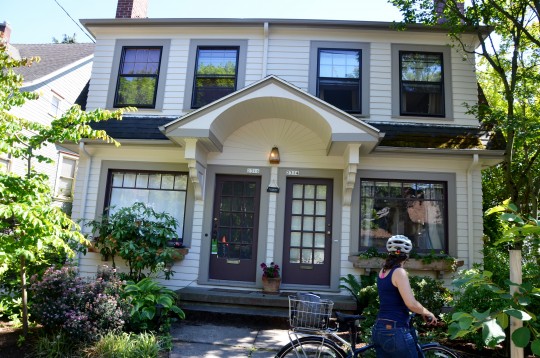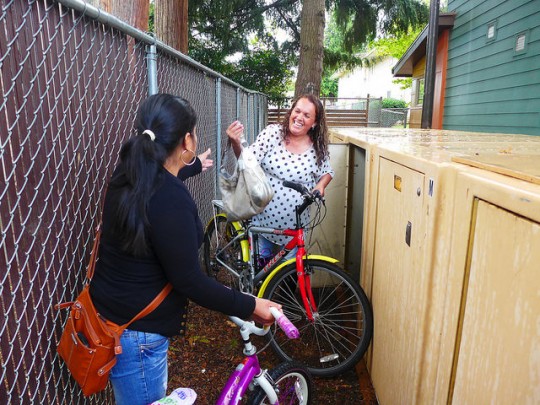
(Photo: M.Andersen/BikePortland)
As Portlanders debate ways to deal with the city’s continuing surge of housing prices, a coalition of local affordable-housing developers and service providers says Portland can’t afford to continue banning so-called “missing middle” housing from most of the city.
Duplexes, triplexes, internal home divisions and two-story garden apartments are common throughout many of the neighborhoods Portland built in the early 20th century. Today, those neighborhoods are the city’s most walkable, bikeable and transit-friendly — but since 1959, city code has made it illegal to build more neighborhoods like that. Homes with multiple kitchens or space for fewer than two cars are forbidden even on most residential land in the central city.
The Oregon Opportunity Network, which speaks for 20 local low-income housing providers and advocates, wrote this week that this ban is contributing to the deep Portland housing shortage that has been driving the poorest Portlanders out of homes entirely.
Three city commissioners have said they’d re-legalize missing middle housing, but only in the city core and “within a quarter mile of designated centers, where appropriate.”
“We urge you to support the ‘missing middle’ housing amendment” to the city’s comprehensive plan, the affordability coalition’s policy director Ruth Adkins wrote in a letter to city council dated Wednesday. “But also to go further, by following the City Club’s recommendation to revise the zoning code to allow for middle housing types in residential neighborhoods across the City – not just near centers.”
Last week, members of the nonpartisan local policy organization Portland City Club voted overwhelmingly to support, among many other affordability measures, zoning reform that would allow “missing middle” housing in residential-zoned Portland neighborhoods.
Three city commissioners — Nick Fish, Dan Saltzman and Mayor Charlie Hales — have backed comprehensive plan amendment #P45, which would re-legalize missing middle housing, but only in the city core and “within a quarter mile of designated centers, where appropriate.”

“One of the main drivers of expensive housing is minimum lot sizes,” Adkins wrote. “Portland needs more, and smaller lots. Portland suffers from a severe shortage of lots for homes – particularly single-family homes – which can only be solved by redefining what constitutes an acceptable legal lot under our zoning and comp plan. Such a change could open up thousands of new lots for homes, all over the city.”
Advertisement
Oregon ON offered a series of anecdotes of the ways lot-size minimums are blocking lower-income Portlanders from buying into the city’s housing market:
● At PCRI, land owned by the organization for over 20 years could be developed or redeveloped for new affordable homes, including for homeownership. This land is located in residential zones throughout north and inner northeast Portland, but minimum lot sizes limit the number of homes that can be developed, handicapping our opportunity to deliver affordable homes for hundreds of families eager to purchase them.
● At the Portland Housing Center, our pool of pre-qualified first-time buyers is larger than ever. But the private market continues to almost exclusively produce large and expensive homes, far out of reach to our buyers. Hence many buyers are failing to find homes to purchase – or being driven farther and farther away from amenity-rich neighborhoods and employment centers to find anything they can afford.
● At Human Solutions, we are seeing a 30 percent increase in demand for our family shelter as more families and children cycle into homelessness and an almost weekly narrowing of the universe of private market rental units in historically affordable East County that will accept our families and our rent assistance partnership. At the very same time that we are seeing the volume of publicly financed units that are affordable and accessible to very low-income families experiencing homelessness shrink and our inability to financially compete with private developers and speculators who are buying up the stock of marketbased affordable properties that are currently housing our client families in East Portland. Without action, those currently affordable properties will disappear from the affordable inventory as private redevelopment shrinks the supply even further.
● At Proud Ground, Portland’s home ownership funding cap of $60K/unit and lack of funding outside of Urban Renewal Areas has not kept up with market realities. This makes it harder than ever to get new homes into trust for permanent affordability.
● At Habitat for Humanity Portland/Metro East, we have 10+ eligible buyers for each house we build. But it has become a significant struggle to time find land we can afford on which to build new developments of affordable homes. We’re entirely priced out of single-family zoned portions of the city, where lots typically go for $200K+ per lot.
Hales planning policy advisor Camille Trummer said in an interview Friday that the mayor is “leaning toward” allowing missing-middle housing in more residential areas rather than just the immediate vicinity of “designated centers.”
“The mayor is very interested in middle housing,” she said. “He’s depending on advocacy from various groups to help calibrate how we form that policy going forward.”

(Photo: Jaclyn Hoy for Community Cycling Center)
Oregon ON also includes direct service providers like Catholic Charities/Caritas Housing, Central City Concern and Home Forward as well as nonprofit community development corporations like Hacienda CDC in Cully and ROSE Community Development in outer southeast Portland.
The coalition doesn’t suggest that simply increasing housing supply and shrinking minimum lot sizes will be enough to help low-income Portlanders or preserve income diversity within neighborhoods. It strongly supports a proposal from Commissioner Amanda Fritz to set a goal of 10,000 new regulated affordable housing units to the city by 2035.
“Zoning reform won’t be enough on its own,” Adkins wrote to the city council. “Although the changes noted above will increase the availability of reasonably priced home lots, nonprofit developers and first-time home buyers will still face sharp competition with market developments and more affluent buyers – especially in amenity-rich neighborhoods. It is essential that Portland immediately build on our hard-won progress in Salem and implement a mandatory Inclusionary Zoning policy, along with an excise tax on new construction of at least 1 percent, dedicated to affordable housing.”
The comprehensive plan amendments in question are P45 (missing middle housing and near “designated centers”) and P46 (at least 10,000 new price-regulated units).
If you’d like to weigh in on these issues yourself, you can email cputestimony@portlandoregon.gov until 2 p.m. on Wednesday, April 27.
— Michael Andersen, (503) 333-7824 – michael@bikeportland.org
The Real Estate Beat is a regular column. You can sign up to get an email of Real Estate Beat posts (and nothing else) here, or read past installments here.



